Lupinus odoratus is a species of lupine known by the common name Mojave lupine. It is native to the Mojave Desert and adjacent western Great Basin in the United States, where it grows in sandy or gravelly soils in open habitat.

Lupinus sparsiflorus is a species of lupin native to North America. In the United States it occurs in California, Nevada, Arizona and Utah, and in Mexico it is found in Baja California and Sonora. Other common names include Mojave lupine, a name it shares with Lupinus odoratus.
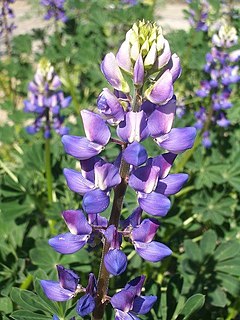
Lupinus succulentus is a species of lupine known by the common names hollowleaf annual lupine, arroyo lupine, and succulent lupine.
Lupinus adsurgens is a species of lupine known by the common name Drew's silky lupine. It is native to the Sierra Nevada and coastal mountain ranges of northern California and southern Oregon, where it grows in forest and other mountain habitat. It is a perennial herb growing 20–60 centimetres (7.9–23.6 in) in height. Each palmate leaf is made up of 6 to 9 leaflets each up to 5 centimetres (2.0 in) long. The herbage is hairy and silvery or gray-green in color. The inflorescence is up to 23 centimetres (9.1 in) long, bearing flowers just over a centimeter long. The flower is pale pink or purple to yellowish with a white or yellow patch on the banner. The fruit is a silky-haired legume pod 2 to 4 centimetres (1.6 in) long containing 3 to 6 seeds.
Lupinus andersonii is a species of lupine known by the common name Anderson's lupine. It is native to California and adjacent sections of Oregon and Nevada, where it grows in dry mountain habitat of various types. This lupine is similar to Lupinus albicaulis in appearance. It is a hairy, erect perennial herb growing 20 to 90 centimeters in height. Each palmate leaf is made up of 6 to 9 leaflets each up to 6 centimeters long. The inflorescence is up to 23 centimeters long, bearing whorls of flowers each roughly a centimeter long. The flower is purple to yellowish or whitish in color. The fruit is a silky-hairy legume pod up to 4.5 centimeters long containing several seeds.
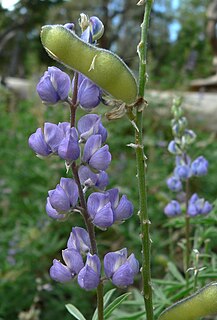
Lupinus argenteus is a species of lupine known by the common name silvery lupine. It is native to much of western North America from the southwestern Canadian provinces to the southwestern and midwestern United States, where it grows in several types of habitat, including sagebrush, grassland, and forests. This is a perennial herb growing erect to heights anywhere between 10 centimetres (3.9 in) and 1.5 metres (4.9 ft). It is sometimes silvery-hairy in texture and sometimes nearly hairless. Each palmate leaf is made up of 5 to 9 leaflets each up to 6 centimetres long. They are narrow and linear in shape, under a centimetre wide. The inflorescence bears many flowers, sometimes arranged in whorls. The flower is 5 millimetres (0.20 in) to 14 millimetres (0.55 in) long and purple, blue, or whitish in color. The banner, or upper petal, of the flower may have a patch of white or yellow. The fruit is a hairy legume pod up to 3 centimeters long containing several beanlike seeds.
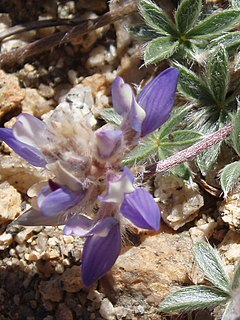
Lupinus breweri is a species of lupine known by the common names Brewer's lupine and matted lupine. It is native to much of California, except for the deserts, and to adjacent sections of Oregon and Nevada, where it is common in some areas, particularly mountain forests. Quite short for a lupine, this is a hairy, mat-forming perennial herb, sometimes becoming like a shrub, with a woody base. The leaves spread out from the stem. Each palmate leaf is made up of 5 to 10 woolly leaflets each up to 2 centimeters (0.79 in) long. The inflorescence is a dense raceme of flowers a few centimeters tall, each flower 4 to 11 millimeters. The flower is blue or purple with a white or yellowish spot on the banner. The fruit is a silky-hairy legume pod 1 or 2 millimeters long.
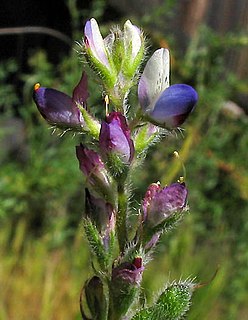
Lupinus concinnus is a species of lupine known by the common name Bajada lupine. It is native to the southwestern United States from California to Texas, and northern Mexico, where it is known from many types of habitat. This is a hairy erect or decumbent annual herb with a stem growing 10 to 30 centimeters long. Each small palmate leaf is made up of 5 to 9 leaflets up to 3 centimeters long and under a centimeter wide, sometimes narrow and linear in shape. The inflorescence is a dense spiral of flowers, with some flowers also appearing in leaf axils lower on the plant. Each flower is 5 to 12 millimeters long and purple, pink, or nearly white in color. The fruit is a hairy legume pod around a centimeter long.

Lupinus flavoculatus is a species of lupine known by the common name yelloweyes, or yellow-eyed lupine.,
Lupinus grayi is a species of lupine known by the common name Sierra lupine. It is endemic to California, where its distribution extends the length of the Sierra Nevada and its foothills and includes the Tehachapi Mountains.
Lupinus holmgrenianus is a species of lupine known by the common name Holmgren's lupine. It is native to the desert mountains of western Nevada and a few ranges of adjacent Inyo County, California, including the Last Chance Range of Death Valley National Park. This is a hairy perennial herb growing erect to a maximum height near 70 centimetres (28 in). Each palmate leaf is made up of 4 to 7 leaflets up to 5 centimetres (2.0 in) long. The inflorescence is a spiral of flowers each just over a centimeter long. They are purple in color with yellow patches on their banners. The fruit is a hairy legume pod 4 or 5 centimeters long.
Lupinus hyacinthinus is a species of lupine known by the common name San Jacinto lupine. It is native to the mountains of southern California and adjacent Baja California, where it grows in dry areas, often in pine forests. It is a perennial herb growing erect to a maximum height of one meter. It is hairy in texture, its newer herbage gray-green in color. Each palmate leaf is divided into up to 12 narrow leaflets up to 8 centimeters long and a few millimeters wide. The inflorescence bears whorls of flowers each over one centimeter long. The flower is purple or blue with a white to yellow patch on its banner. The fruit is a silky-haired legume pod 3 or 4 centimeters long containing speckled seeds.
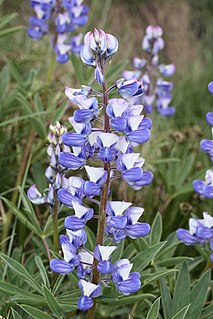
Lupinus latifolius is a species of lupine known by the common name broadleaf lupine. It is native to western North America from British Columbia to Baja California to New Mexico, where it is common and can be found in several types of habitat. There are several subtaxa, described as subspecies or varieties, some common and some rare. They vary in morphology. In general this plant is an erect perennial herb. It grows 30 centimeters to over two meters in height, in texture hairy to nearly hairless. Each palmate leaf is made up of several leaflets, those on larger plants up to 10 centimeters long. The inflorescence bears many flowers, sometimes in whorls. Each flower is one to two centimeters in length, purple to blue to white in color, the spot on its banner yellowish, pinkish, or white.
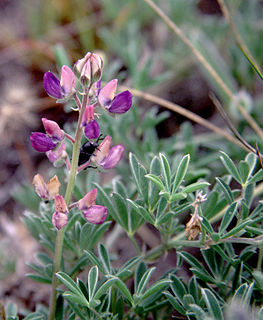
Lupinus littoralis is a species of lupine known by the common name seashore lupine. It is native to the coastline of western North America from British Columbia to northern California, where it grows in sandy habitat. It is a low perennial herb or subshrub growing in a clump or mat no more than 30 centimetres (12 in) tall. Each palmate leaf is divided into 5 to 9 leaflets up to 3.5 centimetres (1.4 in) long. The herbage is coated in long, shaggy whitish or silvery hairs. The inflorescence is raceme of whorled flowers each around a centimeter long. The flower is purple in color with a white patch on its banner that fades pinkish. The fruit is a hairy legume pod 3 or 4 centimeters long containing up to 12 seeds.
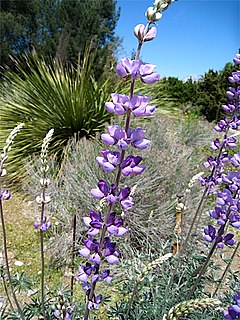
Lupinus longifolius is a species of lupine known by the common name longleaf bush lupine.
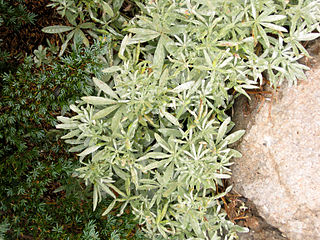
Lupinus obtusilobus is a species of lupine known by the common name bluntlobe lupine. It is native to high mountains of northern California, including the North Coast Ranges, the Klamath Mountains, and the northernmost Sierra Nevada. It grows in various types of mountain habitat, sometimes carpeting meadows with its purple blooms in the spring. It is a perennial herb growing erect or decumbent along the ground, its stem 15–30 centimetres (5.9–11.8 in) long. Each palmate leaf is made up of 6 to 7 leaflets up to 5 centimetres (2.0 in) long. The herbage is coated in silvery silky hairs. The inflorescence is a small raceme with a few whorls of flowers each just over a centimeter long. The flower is blue to purple with a yellowish patch on its banner. The fruit is a silky-haired legume pod up to 4 centimetres (1.6 in) long.
Lupinus onustus is a species of lupine known by the common name Plumas lupine. It is native to the high mountains of northern California, from the northern Sierra Nevada to the Klamath Mountains where its distribution extends just into Oregon. It grows in mountain forest habitat, sometimes on serpentine soils. It is a perennial herb with a short, decumbent stem and erect inflorescence reaching heights between 20 and 30 centimeters. Each palmate leaf is made up of 5 to 9 leaflets up to 5 centimeters long. The stout inflorescence bears many unwhorled flowers each around a centimeter long. The flower is partly or entirely purple in color.

Lupinus sericatus is a species of lupine known by the common name Cobb Mountain lupine. It is endemic to the North Coast Ranges of California north of the San Francisco Bay Area, where it grows in the forest, woodlands, and chaparral of the slopes and canyons. It easily colonizes disturbed habitat as well. This is a perennial herb growing up to half a meter tall. Each palmate leaf is made up of 4 to 7 distinctive wide spoon-shaped leaflets each 3 to 5 centimeters long. The inflorescence is a raceme of several whorls of purple flowers, each flower between 1 and 2 centimeters long. The fruit is a hairy legume pod 2 or 3 centimeters long.
Lupinus tidestromii is a rare species of lupine known by the common names clover lupine and Tideström's lupine. It is endemic to the coastline of California just to the north and south of the Golden Gate in Sonoma, Marin, and Monterey Counties. It is a plant of the sand dunes at separate beach locations in these counties. A very limited amount of this plant's habitat remains; it is a federally listed endangered species. Construction of golf courses on the Monterey Peninsula caused the extirpation of two known occurrences, and boardwalks were built at Asilomar State Beach to prevent trampling of the delicate dune habitat there.

Lupinus truncatus is a species of lupine known by the common name collared annual lupine.














